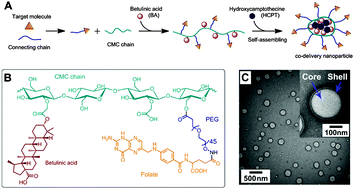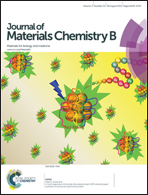A novel self-assembled targeted nanoparticle platform based on carboxymethylcellulose co-delivery of anticancer drugs
Abstract
Single-drug therapy for cancer is greatly hampered by its non-specific delivery to the target tissue, limited efficacies, poor tolerability, and resistance profiles. In order to overcome these limitations, we developed a new targeted nanoparticle platform for co-delivery of two different anticancer drugs. A conjugate based on carboxymethylcellulose (CMC) was first synthesized by introducing hydrophilic molecules (PEG), target molecules (folate), and drug molecules (betulinic acid) into CMC. Then another anticancer drug hydroxycamptothecine (HCPT) was encapsulated into the nanoparticles from the conjugate using a simple nanoprecipitation method. The obtained nanoparticles possessed appropriate size (∼180 nm), high drug loading efficiency (∼23 wt% BA, 21.15 wt% HCPT), a slow drug release rate, higher blood circulation half-time of free BA (6.4-fold) and HCPT (6.0-fold), and high synergetic activity of BA and HCPT toward cancer cells. Furthermore, the targeted nanoparticles showed rapid cellular uptake by tumor cells. The antitumor effect of the nanoparticles in a mouse tumor xenograft model exhibited a much better tumor inhibition efficacy and fewer side effects than that of BA and HCPT, strongly supporting their application as efficient carriers for anticancer therapy.


 Please wait while we load your content...
Please wait while we load your content...